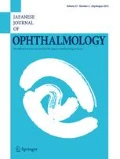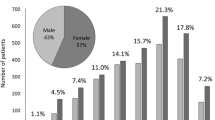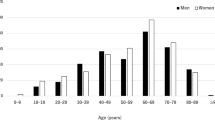Abstract
Purpose
To investigate etiologic data on intraocular inflammation in Japan collected in the 2009 epidemiologic survey of uveitis in Japan and assess the current state of etiology compared with that reported in a previous survey.
Methods
Thirty-six university hospitals participated in this prospective etiologic study. Patients who visited the outpatient uveitis clinic of each hospital for the first time between 1 June 2009 and 31 May 2010 were enrolled in the study. Uveitic diseases were diagnosed according to the guidelines when available or following commonly accepted diagnostic criteria.
Results
A total of 3,830 patients were enrolled in the survey and 2,556 cases of uveitis were identified, of which 1,274 cases were described as unclassified intraocular inflammation. In the identified cases, the most frequent intraocular inflammatory disease was sarcoidosis (10.6 %), followed by Vogt–Koyanagi–Harada disease (7.0 %), acute anterior uveitis (6.5 %), scleritis (6.1 %), herpetic iridocyclitis (4.2 %), Behçet’s disease (3.9 %), bacterial endophthalmitis (2.5 %), masquerade syndrome (2.5 %), Posner–Schlossman syndrome (1.8 %), and retinal vasculitis (1.6 %).
Conclusions
The current etiology of uveitis in Japan was elucidated by means of a multi-center prospective survey. Conducting such surveys on a periodic basis may help clinicians in their management of uveitis.
Similar content being viewed by others
Introduction
Genetic, geographic, social, and environmental factors affect the distribution of the types and etiology of uveitis. A significant correlation had been reported between acute anterior uveitis (AAU) and human leukocytic antigen (HLA)-B27 [1], birdshot retinochoroidopathy and HLA-A29 [2], and Vogt–Koyanagi–Harada disease (VKH) and HLA-DR4 [3]. Human T cell lymphotropic virus type-1 (HTLV-1)-associated uveitis is localized to southern Japan [4], and Behçet’s disease is seen frequently in Asia and the Mediterranean basin [5]. However, the incidence of Behçet’s disease in Japan has decreased in recent decades [6, 7], suggesting that the onset of this disease might be correlated with social and environmental factors. Therefore, studies of the distribution of the various types of uveitis and their etiology are important for establishing an appropriate diagnosis and management.
In 2002, the Japanese Ocular Inflammation Society (JOIS) conducted a multi-center retrospective survey to delineate the status of intraocular inflammation in university hospitals nationwide [8]. The survey found that sarcoidosis was the most frequent intraocular inflammatory disease identified, followed by VKH and Behçet’s disease. However, since social and environmental factors can change over time, it is important to conduct this kind of research periodically. Consequently, a working group of the JOIS conducted a multi-center prospective survey to accumulate etiologic data on uveitis in Japan and assess the changes over time.
Materials and methods
Thirty-six university hospitals participated in this prospective etiologic study. The Institutional Review Board of each center approved the study protocol.
Patients who presented for the first time at the outpatient uveitis clinic of each hospital between 1 June 2009, and 31 May 2010 were enrolled. Once the cause of the uveitis was diagnosed in each patient, we recorded the disease. When possible, the diagnosis of the uveitic disease was based on the guidelines; when this was not possible, common diagnostic criteria reported in the literature were used [9–13].
Several changes in the classification criteria had been made between the 2002 [8] and 2009 survey. First, scleritis was not included in the previous survey, but was included in the 2009 survey. Second, the previous survey differentiated ankylosing spondylitis and HLA-B27 from other types of AAU and recorded them as either ankylosing spondylitis-associated uveitis or uveitis associated with HLA-B27. The 2002 survey recorded AAU from unknown etiologies as unclassified intraocular inflammation. In the 2009 survey, since our aim was to determine the precise relationship between HLA-B27 and AAU, we classified AAU as HLA-B27-positive, HLA-B27-negative, and unknown HLA. Third, we classified viral infectious diseases into groups based on the findings of viruses detected by PCR assays, the absence of viruses based on PCR assays, and clinical diagnosis only (without PCR assay). Fourth, we added a masquerade syndrome to the 2009 survey.
All data were collected at the end of December 2010. Patients with undiagnosed uveitis at that time were classified as having unclassified intraocular inflammation.
Results
A total of 3,830 patients were enrolled in the study, among whom 2,556 cases of uveitis were identified with a specific etiology and 1,274 cases were recorded with unclassified intraocular inflammation. Among the identified cases, 75.4 % were non-infectious diseases and 24.6 % were infectious diseases.
Table 1 shows the distribution of specific intraocular inflammatory diseases in this survey. The most frequent intraocular inflammatory disease in our Japanese patient population was sarcoidosis, followed by VKH. The third most frequent disease in the 2009 survey was AAU, of which 71 patients were HLA-B27 positive, 74 patients were HLA-B27-negative, and the remaining 105 patients had an unknown HLA type.
Table 2 summarizes the causes of scleritis, the fourth most frequent disease in the 2009 survey. Many cases were associated with rheumatoid arthritis; however, some cases were identified as infectious. In herpetic iridocyclitis, the PCR assays detected similar numbers of cases of herpes simplex virus, varicella-zoster virus (VZV), and cytomegalovirus (Table 3). VZV was the most frequent disease entity detected by PCR assays in acute retinal necrosis (Table 4), while about 50 % of the disease entity in masquerade syndrome was primary intraocular lymphoma (Table 5).
When the disease frequencies were analyzed by geographic area, the frequency of uveitis associated with HTLV-1 in the Kyushu area (3.1 %; average of five university hospitals) was significantly greater than the national average (0.8 %; P < 0.05, chi-square test). The other diseases did not differ significantly among the geographic areas.
Discussion
This was the first multi-center prospective nationwide etiological survey of uveitis in Japan. Using the data from this survey, we have elucidated the current etiology of uveitis in Japanese university hospitals and found that sarcoidosis, VKH, AAU, and scleritis occur at a high frequency, followed by a relatively large number of cases of Behçet’s disease and masquerade syndrome.
The 2009 survey differs somewhat from the retrospective survey of intraocular inflammation conducted at 41 university hospitals in 2002 [8]. Different institutions participated in the two surveys, although there was an overlap of many institutions. In addition, the disease classifications differed between the two surveys. For example, in the 2009 survey, we included scleritis, which was not included in the 2002 survey. Scleritis comprised 6.1 % of all cases in the 2009 survey; one-fourth of these cases were associated with rheumatoid arthritis, while half had an unknown etiology. The masquerade syndrome had also been excluded from the 2002 survey, and only intraocular lymphoma was included. In the 2009 study, the masquerade syndrome comprised 2.5 % of all cases; about one-half of these (1.3 %) were cases of intraocular lymphoma. Intraocular lymphoma comprised 1.0 % of the diseases surveyed during 2002, indicating that the incidence of this disease remained virtually unchanged. Lymphoma is usually associated with a poor prognosis, and care should be taken not to misdiagnose patients with this disease entity. In the 2002 survey, of all the AAU cases, only HLA-B27-associated uveitis was included and the other types were classified in the unclassified category. HLA-B27-associated uveitis accounted for 1.5 % of the cases in the 2002 survey and 1.9 % in the 2009 survey; therefore, the incidence of HLA-B27-associated uveitis would appear to be largely unchanged.
The number of patients with Behçet’s disease in Japan has been reported to decrease [6, 7], and the incidence in the 2009 study was 3.9 %. Compared to the previous survey [8], the incidence of patients with newly diagnosed Behçet’s disease in Japan has decreased from 6.2 to 3.9 %, although the two surveys cannot really be compared because of the different participating institutions. The decrease in the number of patients with Behçet’s disease in Japan over nearly a decade suggests that the disease might be correlated with exogenous factors, such as climate, public health, and dietary habits, rather than endogenous factors, such as age, sex, ethnicity, and immunogenetic background.
Geographically, HTLV-1-associated uveitis was still more frequently diagnosed in the Kyushu area, a result similar to that of the 2002 survey. However, there was no marked variation in the geographical distribution of the other types of uveitis. This indicates that ophthalmologists can consider the results of this survey to be valid on a nationwide basis.
The limitation of the 2009 survey is that only university hospitals participated. It should be kept in mind that Sakai and associates report that diabetic iritis and herpetic iritis are seen significantly more frequently in general eye clinics, whereas VKH and Behçet’s disease are seen significantly more often in university hospitals [14]. In addition, the 2009 survey did not consider age and sex. These factors should be considered in any future survey.
Investigations of epidemiologic changes over time require comparisons of periodically acquired etiologic data from the same diagnostic categories and from the same institutions. In addition, to standardize the diagnosis in all participating institutions in the survey, easily understandable diagnostic guidelines for intraocular inflammation are needed. Moreover, a national epidemiologic survey should include not only university hospitals but also clinics. In the next survey, these factors need to be considered in order to establish a well-designed format for a periodic epidemiologic national survey.
References
Derhaaq PJ, de Waal LP, Linssen A, Feltkamp TE. Acute anterior uveitis and HLA-B27 subtypes. Invest Ophthalmol Vis Sci. 1988;29:1137–40.
Levinson RD, Rajalingam R, Park MS, Reed EF, Gjertson DW, Kappel PJ, et al. Human leukocyte antigen A29 subtypes associated with birdshot retinochoroidopathy. Am J Ophthalmol. 2004;138:631–4.
Shindo Y, Inoko H, Yamamoto T, Ohno S. HLA-DRB1 typing of Vogt-Koyanagi-Harada’s disease by PCR-RFLP and the strong association with DRB1*0405 and DRB1*0410. Br J Ophthalmol. 1994;78:223–6.
Mochizuki M, Watanaebe T, Yamaguchi K, Tajima K. Human T-lymphotropic virus type 1-associated disease. In: Pepose JS, Holland GN, Wilhelmus KR, editors. Ocular infection and immunity. St. Louis: Mosby; 1996. p. 1366–87.
Chang JH, Wakefield D. Uveitis: a global perspective. Ocul Immunol Inflamm. 2002;10:263–79.
Kotake S. Epidemiology of Behçet disease. Clin Ophthalmol. 2003;57:1308–10.
Yoshida A, Kawashima H, Motoyama Y, Shibui H, Kaburaki T, Shimizu K, et al. Comparison of patients with Behçet’s disease in the 1980s and 1990s. Ophthalmology. 2004;111:810–5.
Goto H, Mochizuki M, Yamaki K, Kotake S, Usui M, Ohno S. Epidemiological survey of intraocular inflammation in Japan. Jpn J Ophthalmol. 2007;51:41–4.
Forrester JV, Okada AA, Ohno A, BenEzra D, editors. Posterior segment intraocular inflammation: guidelines. Amsterdam: Kugler; 1998.
BenEzra D, Ohno S, Secchi AG, Alio J, editors. Anterior segment intraocular inflammation: guidelines. London: Martin Dunitz; 2000.
Ministry of Health, Labour and Welfare Designated Disease Study Group. Ministry of Health, Labour and Welfare. Diagnostic criteria of Behçet’s disease (revised edition, 2003) (in Japanese). Ministry of Health, Labour and Welfare, Tokyo; 2003. pp. 11–13.
Read RW, Holland GN, Rao NA, Tabbara KF, Ohno S. Arellanes-Garcia, et al. Revised diagnostic criteria for Vogt–Koyanagi–Harada disease: report of an international committee on nomenclature. Am J Ophthalmol. 2001;131:647–52.
Sugisaki K: Diagnostic guidelines and criteria for sarcoidosis—2006 (in Japanese). Nihon Kokyuki Gakkai Zasshi. 2008;46:768–80.
Sakai JI, Usui Y, Sakai M, Yokoi H, Goto H. Clinical statistics of endogenous uveitis: comparison between general eye clinic and university hospital. Int Ophthalmol. 2010;30:297–301.
Acknowledgments
The authors wish to thank the institutions that participated in this survey: Hokkaido University, Asahikawa Medical University, Akita University, Tohoku University, Yamagata University, Fukushima Medical University, Dokkyo Medical University, Chiba University, Nihon University, Jikei University, Juntendo University, Kitasato University, Tokyo Medical University, Tokyo Medical and Dental University, University of Tokyo, Yokohama City University, Kyorin University, Gifu University, Niigata University, Kanazawa University, Kyoto University, Kyoto Prefectural University, Osaka University, Osaka Medical College, Osaka City University, Kinki University, Kobe University, Shimane University, Hiroshima University, Ehime University, Kochi University, Fukuoka University, Kyushu University, Saga University, Kurume University, Kagoshima University. The authors also express their appreciation to Dr. Chiharu Iwahashi for her help with data analysis.
Conflict of interest
The authors have no proprietary interests or conflicts of interest in any aspect of this report.
Author information
Authors and Affiliations
Corresponding author
About this article
Cite this article
Ohguro, N., Sonoda, KH., Takeuchi, M. et al. The 2009 prospective multi-center epidemiologic survey of uveitis in Japan. Jpn J Ophthalmol 56, 432–435 (2012). https://doi.org/10.1007/s10384-012-0158-z
Received:
Accepted:
Published:
Issue Date:
DOI: https://doi.org/10.1007/s10384-012-0158-z




